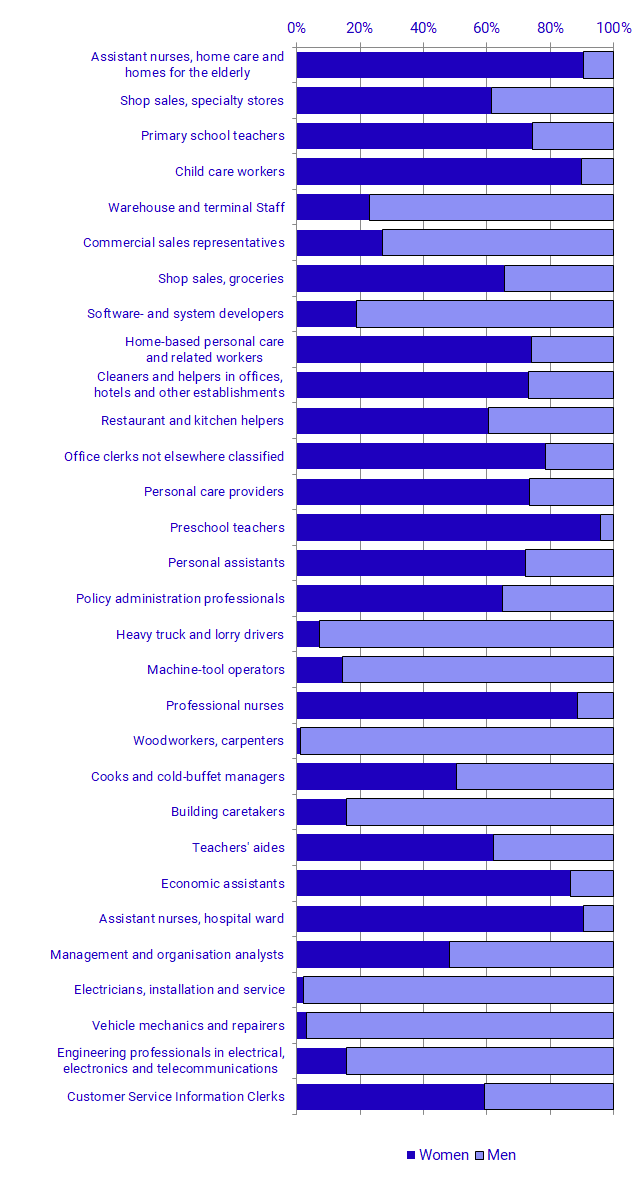The Swedish Occupational Register with statistics 2019
Most common occupation was “assistant nurses, home care and homes for the elderly”
Statistical news from Statistics Sweden 2021-03-04 9.30
The most common occupation in Sweden was “assistant nurses, home care and homes for the elderly”. Women accounted for 91 percent and men accounted for 9 percent of people with this occupation. It was also the most common occupation among women. The most common occupation among men was “warehouse and terminal staff”, which was the fifth most common occupation overall. Men accounted for 77 percent and women accounted for 23 percent of people with this occupation.
Among the 30 largest occupations, the distribution by sex was even within four occupations; “cooks and cold-buffet managers”, of which 50 percent were women and 50 percent were men, had the most even balance between the sexes. An even balance means that the distribution between the sexes is 40 percent and 60 percent respectively.

The most common occupation for women was “assistant nurses, home care and homes for the elderly”, of whom there were 119 900 employees with an average age of 45 years, followed by “child care workers”, of whom there were 83 610 employees with an average age of 40 years.
| Occupation1 | Total number of women | Total numer of men | Percent, women | Average age, women |
|---|---|---|---|---|
|
Assistant nurses, home care and homes for the elderly
|
119 900 | 12 410 | 91 | 45 |
|
Child care workers
|
83 610 | 9 560 | 90 | 40 |
|
Primary school teachers
|
80 880 | 27 960 | 74 | 43 |
|
Shop sales, specialty stores
|
68 440 | 43 140 | 61 | 33 |
|
Preschool teachers
|
64 680 | 2 900 | 96 | 43 |
|
Home-based personal care and related workers
|
58 160 | 20 420 | 74 | 36 |
|
Shop sales, groceries
|
56 940 | 30 060 | 65 | 34 |
|
Cleaners and helpers in offices, hotels and other establishments
|
56 830 | 20 740 | 73 | 44 |
|
Office clerks not elsewhere classified
|
55 250 | 15 030 | 79 | 44 |
|
Personal care providers
|
50 440 | 18 160 | 74 | 43 |
1According to the Swedish Standard Classification of Occupations 2012 (SSYK2012) at a four-digit level. The figures are rounded to the nearest 10.
The most common occupation for men was “warehouse and terminal staff”, of whom there were 68 390 employees with an average age of 37 years, followed by “software and system developers”, of whom there were 65 780 employees with an average age of 40 years.
| Occupation1 | Total number of men | Total numer of women | Percent, men | Average age, men |
|---|---|---|---|---|
|
Warehouse and terminal Staff
|
68 390 | 20 260 | 77 | 37 |
|
Software- and system developers
|
65 780 | 15 190 | 81 | 40 |
|
Commercial sales representatives
|
64 400 | 23 990 | 73 | 44 |
|
Heavy truck and lorry drivers
|
53 600 | 4 080 | 93 | 42 |
|
Woodworkers, carpenters
|
45 890 | 610 | 99 | 40 |
|
shop sales, specialty stores
|
43 140 | 68 440 | 39 | 35 |
|
Machine-tool operators
|
43 100 | 7 360 | 85 | 42 |
|
Building caretakers
|
35 000 | 6 590 | 84 | 46 |
|
Electricians, installation and service
|
33 060 | 760 | 98 | 37 |
|
Vehicle mechanics and repairers
|
32 240 | 1 080 | 97 | 39 |
1 According to the Swedish Standard Classification of Occupations 2012 (SSYK2012) at a four-digit level. The figures are rounded to the nearest 10.
Definitions and explanations
Information concerning employees is reported for those aged 16-64 years classified as gainfully employed in the register-based labour market statistics (RAMS). The classification of gainfully employed persons is mainly based on the monthly employer reports at individual level from the Swedish Tax Agency. To be classified as gainfully employed, the person must have received a salary in November that exceeds SEK 99, or must conduct a business activity. In addition, the person must be entered in the population register in Sweden on 31 December and be aged between 16 and 74 years old. Even those who were temporarily absent during the measurement period, for instance due to sickness or parental leave, are included in the frame. The term ‘employee’ also includes self-employed persons who run their operations as a limited company.
The occupations follow the classifications used in the Swedish Standard Classification of Occupations (SSYK 2012).
Next publishing will be
The next statistical news in this series will be published in March 2022.
Statistical Database
More information is available in the Statistical Database
Feel free to use the facts from this statistical news but remember to state Source: Statistics Sweden.
